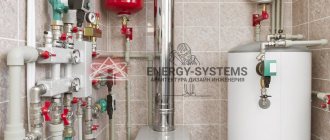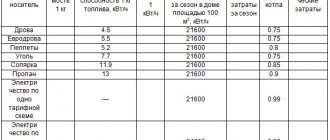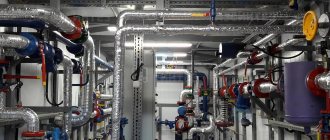Legislation in the field of electricity provides for the use of several types of tariffs for electricity transmission services.
In addition, probably every power engineer at an enterprise has at least once heard the terms “boiler from above”, “boiler from below”, “boiler holder”. At the same time, it is often unclear how electricity consumers depend (and whether they depend at all) on these “boilers” and why different tariffs are needed if they pay for electricity transmission services only one at a time. Let's figure it out.
Boiler pricing is used to determine tariffs for services for the transmission of electrical energy and the application of these tariffs in settlements between electricity consumers and network organizations, as well as between network organizations.
Its essence boils down to the following:
Before the start of the calendar year, the executive body in the field of state regulation of tariffs of the subject of the federation (REC of the region) collects proposals on the size of prices (tariffs) from the network organization. From these proposals, containing the necessary gross revenue (GRR, the amount of money needed by the network organization to conduct activities), the required gross revenue of the region is formed. This is the so-called boiler.
In order for the boiler to fill, the regional energy commission calculates and approves unified (boiler) tariffs broken down by voltage levels (HV, CH1, CH2, LV). All consumers of the same voltage level in the region pay for electricity transmission services at the same tariffs, regardless of which grid organization they are connected to and how many grid organizations are “on top”.
Next, the question arises of how to divide this pot between network organizations and who will fill it, that is, receive money from consumers.
There are several options:
Boiler from above
In the region there is a boiler holder - a network organization that enters into contracts on its own behalf with all consumers (or guaranteeing suppliers and energy sales organizations representing their interests), regardless of which network organization the consumers are connected to. Usually the boiler holder is a branch of IDGC.
The boiler holder collects all the money, and then distributes the share due to other network organizations operating in the region to them.
Settlements between grid organizations are carried out according to individual tariffs for electric energy transmission services , which the Regional Energy Commission of the region calculates based on the required gross revenue of grid organizations.
In the boiler-on-top scheme, tariffs are calculated so that the boiler holder transfers all of their NVV to adjacent network organizations.
This scheme is beneficial to the boiler holder. Related network organizations receive money on a residual basis. If there are non-payments on the part of consumers of transmission services (and they always exist), the boiler holder first “satisfies his appetite” and then transfers the money to adjacent network organizations.
Boiler from below
The opposite situation is when consumers (suppliers of last resort, energy sales organizations) enter into an agreement for the provision of electricity transmission services with the network organization to whose networks the consumer is connected. Next, the network organization transfers the money to a higher-level network organization. Individual tariffs for settlements between network organizations are set in such a way that network organizations transfer “upward” the difference between the money collected from consumers at unified (boiler) tariffs and their required gross revenue.
The implementation of such a scheme naturally benefits network organizations whose networks supply consumers with power. In this case, the IDGC branch receives part of the money last.
Consumers powered by IDGC networks, in principle, do not care what boiler generation scheme is used. In any case, they enter into an agreement and pay for electricity transmission services to IDGC.
Mixed boiler
Some network organizations in the region operate according to the boiler-on-top scheme, while others operate according to the boiler-on-bottom scheme. Mixed boilers arise when the boiler from below does not allow the redistribution of funds received from consumers in such a way that all network organizations receive their RRR.
Boiler on the side
Today, an already extinct type of boiler tariff formation, when the boiler holder is the supplier of last resort.
You will learn about current changes in the Constitutional Court by becoming a participant in the program developed jointly with Sberbank-AST CJSC. Students who successfully complete the program are issued certificates of the established form.
The program was developed jointly with Sberbank-AST CJSC. Students who successfully complete the program are issued certificates of the established form.
Document overview
Document overview
In relation to the case of payment for electricity transmission services, the Judicial Collegium for Economic Disputes of the Supreme Court of the Russian Federation noted the following.
Monogrids have been removed from the boiler model of payment for services. A monoconsumer whose power receiving devices are connected to monogrids must pay for electricity transmission services to the monogrid at the tariff established for it. If territorial grid organizations are also used to transmit electricity to this consumer, then their services are paid by the consumer to these network organizations at a single boiler tariff.
Within the framework of the boiler model, the consumer orders the “delivery” of electricity to his energy receiving device from one contractor, who transports it both independently and with the involvement of other network organizations. In this case, the place of fulfillment of the network organization’s obligations to provide services is the delivery point located on the border of the balance sheet of the consumer’s power receiving device and the networks of the last of the network organizations involved in the transmission. Either this will be the point of connection of the consumer’s power receiving device to an ownerless network or power grid facility of a person who does not provide electricity transmission services.
Outside the framework of the boiler model, each network organization from those whose networks are sequentially involved in the transmission of electricity to the end consumer participates in legal relations with it independently within its network section. Consequently, the scope of services of intermediate network organizations participating in the transmission chain must be determined at the point of connection of adjacent networks. In this case, the service delivery point will also be located there. Services are paid according to tariffs established for each network organization, for the volume of services provided by each of them.
Soon there will be no “cameras in the bushes” in the Tyumen region
Complete check of Tyumen drivers postponed due to rain
August 1: waiting for changes
Causes and provoking factors
The main reasons that can form a leak in a gas boiler are:
- Hole in the water heating tank – is caused by metal corrosion, which especially often affects those units that have been in continuous operation for more than 10 years. With frequent contact of water with a metal surface, rust forms, which gradually corrodes the water heater. At first it will be the smallest hole, which will not make itself felt for the time being. But at one fine moment a hole
will reach impressive sizes that cannot be missed with the naked eye. - Poorly tightened fittings and lack of tightness at the joints - water will constantly leak, forming drops that very quickly develop into puddles. This once again emphasizes the importance and necessity of proper installation of the heating system.
- A hole in the water heater along the weld seam - a manufacturing defect is difficult to check or identify before purchasing equipment. Usually the problem occurs exactly when the warranty period has expired. It is almost impossible to prove anything in such a situation, but you will have to spend money on expensive repairs or replacement of this part of the boiler.
- Burnout of the walls of the water heater - this is possible if there is a constantly strong flame in the combustion chamber, which, with frequent exposure to the metal, destroys its integrity. Naturally, this will not happen in a week, but over 10 years of continuous operation it is quite possible.
Don't forget about the problem of condensation. It often collects on metal pipes or plastic pipes, forming fairly large drops that supposedly flow out of the boiler.
This is all due to the lack of proper temperature in the room where the boiler is located. If it is below 10℃, and in the heating system the heating of water reaches 60-70℃, a temperature difference is formed, which is the cause of false concern.
Expert opinion
Grebnev Vadim Savelievich
Heating system installer
Naturally, the problem needs to be solved, since high humidity plus metal always equals corrosion, which will lead to the need to replace individual elements of the system.
Now let's look at the provoking factors that together lead to a malfunction of the water heater itself in the heating system:
- The boiler works “to wear out” - the maximum temperatures are set, the flame in the burner literally burns the metal, forming perforations in it.
- The boiler model was chosen incorrectly , the power of which is not designed to heat a huge area of housing. This happens when, in order to save money, for heating private residential buildings, not powerful wall-mounted boilers are purchased, but low-power (7-8 kW) parapet boilers. The result is clear - crazy excessive consumption of fuel and the boiler is working to the point of wear and tear, which threatens constant breakdowns.
- The combustion chamber is installed so low that the high flame of the burner destroys the metal layer.
Consequences of a leak in the boiler
- Using “living” water – water from wells and springs cannot be poured into the heating system, since a large amount of oxygen is dissolved in it. In turn, oxygen provokes the development of corrosion, which will cause leaks not only in the radiators, but also in the boiler itself. Experts recommend pouring only distillate into the expansion tank, but many users of gas equipment ignore this and install automatic make-up from the general water supply system.
- A sharp change in water temperature - when the system has completely cold water and the burner flame is set to maximum. The sudden heating of water leads to rapid expansion of the metal, which provokes cracks, especially in steel floor-standing boilers.
- Lack of annual preventative cleaning of the heating element - a reagent is introduced into the system that dissolves scale and also neutralizes rust in the water. If this is not done, the risk of developing a leak will be high already in the 3rd year of operation of the boiler.
Another important point is the cheap cost of the boiler. Imaginary savings that are achieved through the use of sheet metal that is prone to rapid oxidation with constant contact with the aqueous environment.
The reason for the formation of leaks on the downpipes is incorrect installation. More often this occurs when the installation of a heating system is carried out independently, without skill and experience.
Do not exclude such a problem as starting a heating system without coolant. The metal quickly overheats and is prone to cracks, chips and other damage.
Before starting the heating system, always check the presence of water and monitor the pressure. Start warming up with minimum temperatures, constantly increasing the degrees.
Cold welding
The leak area should be thoroughly dried and cleaned. After this, quickly knead part of the plastic mass with your hands and apply it to the hole so that the diameter of the patch is 2-3 cm larger than the diameter of the through hole. Let it dry for a day, then install the water heater in the boiler and run the system at minimum temperatures
Advantages:
- quick and easy hole repair
- you can solder several perforations at once, including seams
- relatively cheap repair method
Flaws:
- takes time to dry completely
- Not suitable for all types of boilers
- does not work if the boiler operates at high pressure and high temperature
- there is no guarantee that the boiler will not leak in the future
Semi-automatic welding
Semi-automatic welding
The holes are cleaned and dried, after which seams and points are applied to the thinnest areas of the metal structure. Next, the seams are sanded, rubbed, and the water heater is installed in the heating system and filled
Advantages:
- the work takes about 15 minutes
- high strength and reliability
Flaws:
- not suitable in all cases
- Need help from a specialist and equipment
Complete tank replacement
If the old one, after all the methods of eliminating the leak, does not hold water under pressure, then it is better to replace it with a new one. The process consists of purchasing a similar water heater and installing it in its original place
Advantages:
- full guarantee of no leaks in the future
- you can do the installation yourself
Flaws:
- Spending on new equipment
To get maximum confidence in the quality of the work performed, it is better to entrust it to specialists. They will not only quickly find the cause and eliminate it, but also give a guarantee.
Device
The Nedelka boiler contains the following elements:
- partitions that direct the movement of hot air;
- combustion zone;
- multi-pass convective heat exchanger, increasing the efficiency of the boiler to 92%;
- a microprocessor and a fan that regulate the combustion process and maintain the set maintenance;
- door for fuel loading;
- boiler jacket made of steel 5 mm;
- door for removing ash;
- under-grid door for removing ash;
- grate made of seamless thick-walled pipe.
The structure of the Nedelka boiler
Reviews
Reviews of long-burning solid fuel boilers Week are completely different. But there are often recurring moments. For example, people note the positive aspects of heating units; they are pleased that the boiler really burns with various cheap coals for up to 4-5 days and lives up to its name. There is no need to constantly monitor the operation of the device; you flood it and forget it. People highlight the unpretentiousness of the boiler, its safety, simple operation, and efficiency.
At the same time, some users complain about difficult and lengthy cleaning, which, together with kindling, takes 1-1.5 hours. Some are not satisfied with the price of the equipment, others are dissatisfied with the cost of electricity, the possible appearance of condensation, the lack of remote control of the boiler unit, as well as the insulation of the unit body. How many people - so many opinions.
Owner's review of the solid fuel boiler Nedelka
Take note of reviews from real users, read the technical characteristics of these heating units and make a purchasing decision. Solid fuel calving Nedelka will be an excellent solution for heating a residential or industrial premises. This is a real omnivorous cauldron for warmth and comfort, as well as freedom for other things!
Boiler models Nedelka
Four models are popular: KO-60, KO-90, KO-110, KO-150, differing from each other in weight, power and, accordingly, the area of the heated room, as well as other parameters.
| KO-60 | KO-90 | KO-110 | KO-150 | |
| Type of heated room | For a cottage, private house, car wash or service station | For a large house or cottage, service station or car wash | For a large home or industrial premises | For a large home or industrial premises |
| Operating power | 5-60 kW | 15-90 kW | 25-110 kW | 25-110 kW |
| Load capacity | 160 liters | 300 liters | 450 liters | 600 liters |
| Heated area | from 50 to 250 m² | from 150 to 400 m² | from 400 to 800 m² | from 800 to 2000 m² |
| Weight | 420 kg | 650 kg | 850 kg | 1200 kg |
| Operating pressure | 1.5 bar | 1.5 bar | 1.5 bar | 1.5 bar |
| Working temperature | From +35 to +85 °С | from +35 to +85 °С | from +35 to +85 °С | from +35 to +85 °С |
| Dimensions H/W/D | 148/72/110 cm | 171/77/114 cm | 171/79/146 cm | 188/92/160 cm |
| Mounting holes | supply - 32 return - 25 chimney - 159 | supply - 40 return - 32 chimney - 159 | supply - 40 return - 32 chimney - 159 | supply - 40 return - 32 chimney - 159 |
| Price | RUB 111,500 | 159,000 rub. | 210,000 rub. | RUB 295,000 |











